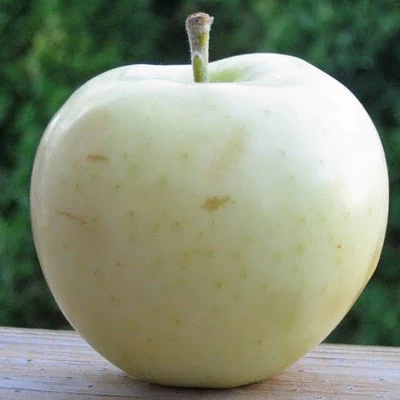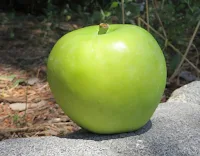
|
There is a charming antique Russian apple called Yellow Transparent, also called White Transparent, of surprising sophistication if you get good ones.
That's challenging as this early August variety is at peak for about 45 minutes.
Almost nobody grows it these days, which is a shame, but there are two modern varieties that sort of fill the same niche.
"Almost" because one of them, Lodi, is really never good, though it is often the first local apple of the year around here and is worth eating for that alone.
The other, Pristine, ripens a little later and is one of my favorite early apples, though it is not very much like Yellow Transparent.

|
| Lodi |
Lodi (rhymes with "show pie") is a Yellow Transparent cross with an apple called Montgomery Sweet. It is an early product of the New York state breeding program in Geneva, New York, the same folks who brought us Macoun and Cortland.
Like Cortland, Lodi is named for a town in the Empire State. The Town of Lodi is located in the Finger Lakes region of that state, not far from Geneva.

|
| Pristine |
Pristine, a more-recent product of the Purdue-Rutgers-Indiana breeding co-op, has little or no Yellow Transparent in its family tree.
Nonetheless it it is an excellent choice in early August, crisp and balanced. Also Pristine stays good for a lot longer than the brief candle of Yellow T's life.
I came to the conclusion that Lodi, though often first, never reaches a fully peak moment. It is either too early, with acid spongy flesh and white pips, or overripe and mealy.
If you snag the Transparent at the right moment, it is quite fine indeed.
See also a comparison of
Lodi vs Transparent, which are often confused. Also a
Lodi vs Pristine
contest, the former a bit overripe and the latter under.
The Pristines I got on Wednesday are very worth eating despite being not fully ripe. I celebrate my first local apple of the year.

Yellow Transparent was widely grown out here in Colorado. Before the days of shipping apples from Chile and New Zealand, it was the first apple of the season. Very important to early pioneers. I think the 45 minutes of peak flavor is on the high side, but it makes a wonderful applesauce. Also the tree ripens over several weeks, so there is good fruit over a longer period. It also bears very reliably.
ReplyDeleteThe apple has that reputation for sauce. I have heard the same things for Pristine too.
DeleteHere in northern California’s we’ve been eating Gravenstein for a week. Sweet and tart, an apple all it’s own. I’m in Sebastopol where we are working to save the Gravenstein as vineyards are more profitable. From 7000 acres to the 700 acres we try to protect them. Even so, we lose too many acres every year. Thanks to Slow Food and their presidium we have a strong group of folks here working to save them. Still, we’re in the middle of wine country.......my orchard has tress planted around 1914, huge trees, green and red gravs. They make great applesauce and hard cider, and are great to eat out of ha d.
ReplyDeleteCoincidentally I heard just last night from a friend in Marin County who got some Gravs at farmers market this week. I'm surprised that they come in that early as they really are a mid-late August variety out here. They are probably my favorite August variety.
DeleteIt would be a real shame if the Gravenstein vanished from Sebastopol of all places!
Gravs are the most versatile apples that I grow here in central Wisconsin. They start ripening in mid to late August and the harvest period goes to the end of September.
DeleteCarole, you are only the second orchardist I know who mixes apples and art. (The other is Linda Hoffman at Old Frog Pond Farm.)
DeleteNo doubt there are others!
We've got some Transparent apple trees here in the West Michigan countryside-- right in our backyard, actually! One of them is reportedly close to 100 years old, and the other two are either the same age or somewhere near 40 years (maybe planted by my great-grandparents). All trees are still producing, though! But unfortunately we don't do much with the apples because they get really wormy since we don't spray them with pesticides or anything. Our mini pony like them, though. :)
ReplyDelete